Lopata Azalea/Rhododendron Garden
This display features azaleas, rhododendron species and cultivars, magnolia hybrids and hardy shade-tolerant companion plants beneath a high canopy of native trees. An enchanting garden throughout the year, flowering peaks in late April and fall color peaks in late October.
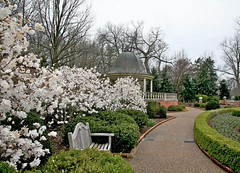 Blanke Boxwood Garden
Blanke Boxwood Garden
The elegant beauty of boxwood has been valued in gardens for thousands of years; from the "pleasure gardens" of ancient Persia, to the landscapes of Greece and Rome, to the formal gardens of Europe. Boxwood gives shape, structure and evergreen foliage to any garden setting. In the spring of 2009, a new entrance was completed. Visitors enter the Boxwood Garden through a handsome open brick courtyard that allows them to see inside the garden. This new opening features a fountain with vertical sprays of water than run continuously. Visitors discover a formal oval boxwood parterre accented with colorful flowers and ground cover. From this spot, visitors enjoy a view of the beautifully designed Boxwood Garden and the surrounding grounds, including the English Woodland Garden and the Kemper Center demonstration gardens.
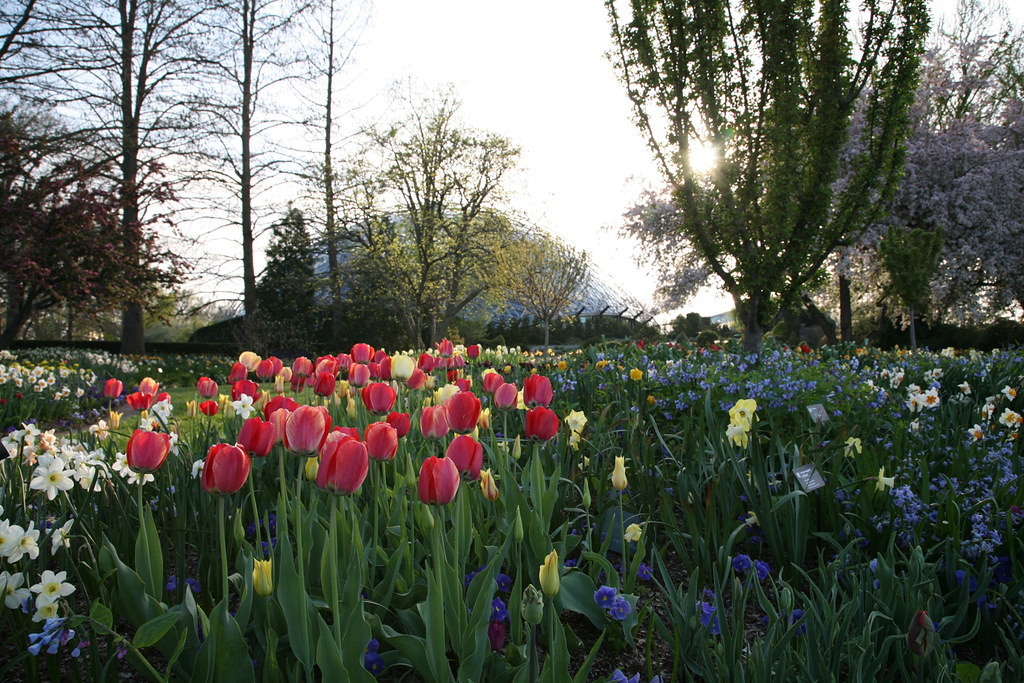
Samuels Bulb Garden and Heckman Bulb Garden
From late February through early November, flowering bulbs and bulbous plants display their brilliance in rolling, brick-lined beds amongst companion shrubbery, flowering trees and annuals. During spring peak, tens of thousands of bulbs representing dozens of different perennial genera bloom in a world-class display. Throughout the summer, many species of tropical bulbs are added, carrying the flowering display through late fall. The summer peak features a wide selection of lilies, cannas, aroids and tropical amaryllids. Nationally-recognized collections of Narcissus and Lilium are featured in these two gardens, as well as many rare and endangered bulbs from around the world.
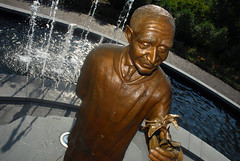 George Washington Carver Garden
George Washington Carver Garden
This inspirational garden honors the life and accomplishments of the extraordinary scientist and native Missourian who greatly influenced 19th and 20th century agriculture and education. Designed for peaceful contemplation and learning, the garden features a small amphitheater surrounding a life-size bronze statue of Dr. Carver, surrounded by a reflecting pool. Plantings of viburnums, hydrangeas and hollies provide a secluded, intimate feeling. The Carver Garden is intended to serve not only as a memorial but also a learning laboratory for educators and students.
 Doris I. Schnuck Children's Garden: A Missouri Adventure
Doris I. Schnuck Children's Garden: A Missouri Adventure
The Children's Garden is all about family fun, play and learning. Children and adults explore themes of adventure and discovery on the 19th century frontier as they learn about the importance of plants in daily life. It opened spring 2006 on nearly two acres west of the Climatron. Of historical note are the large Osage orange trees, believed to date back to Henry Shaw's time. He planted these trees to line the road to his house, which stretched from Tower Grove House to Old Manchester Road, known today as Vandeventer. Also found in this area are several large trees including pin oak, sycamore and tulip poplar. Smaller trees include crabapples, bird cherries and chestnuts.
Courts & Family Gardens
Bakewell Court Garden
Perennial and seasonal bedding plants accent a brick paved courtyard. Ongoing interest.
Cohen Court Garden
A display of plants discovered and described by botanist George Englemann, including unusual cacti, succulents, and herbaceous plants. IN PROGRESS.
Isabelle Baer Garden
A soft rose and blue-grey limestone terrace surrounding two fountains is framed by seasonal displays of bedding plants. IN PROGRESS.
Swift Family Garden
Swift Vista was carefully designed to enhance the views down the Vista and take advantage of the beautiful architecture of the Linnean House. Its features include a formal hornbeam hedge (Carpinus betulus) along the south side of the Vista; seasonal bedding around the pools which display tropical water lilies; and the Swift perennial border which showcases wild-sourced, herbaceous Eurasian species, focusing on some of the world’s most biologically diverse hotspots with climates that are similar to St. Louis including Romania, Central Asia, Altai, and Caucasus plants. Displays in this border will be carefully phased in and will include biennials and perennials grown from seed, resourced through various collecting expeditions and reciprocal trade with foreign institutions. These visually stunning borders represent the Garden’s ongoing efforts toward creating horticulture displays that showcase the Garden's research and conservation efforts and provide visitors the opportunity to experience greater plant diversity. All this under the watchful eyes of the statues of three of the world’s most renowned botanists, if you look carefully I am sure you can see each of them smiling. IN PROGRESS.
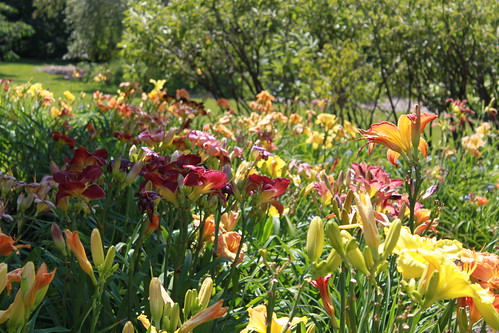
Jenkins Daylily Garden
Adjacent to Shaw's original stone wall, this nationally recognized Daylily Garden provides a link between the Goodman Iris Garden and the Victorian district of the Missouri Botanical Garden. Over 1,800 daylily varieties representing many different award collections, wild species, historic varieties and Missouri-hybridized cultivars bloom throughout June and July, with many reblooming through late fall. Surrounding the daylily plantings is another notable collection of witch hazels (Hamamelis). This collection of over 60 varieties blooms in winter, spanning the entire length of the Daylily Garden on both sides of the path.
Dry Streambed Garden
This informal, meandering dry stream bed is constructed of cobble stones edged throughout with large limestone rock boulders. Flanking the dry stream are plantings of native, rare and endangered, and other ornamental plants typical of this habitat. A small pond at the north end is planted with hardy Missouri native aquatic plants.
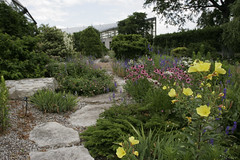
Heckman Rock Garden and Kassabaum Dwarf Conifer Garden
These two delightful gardens are located immediately in front of the Shoenberg Temperate House, crossing the path into the Heckman Bulb Garden. The Heckman Rock Garden features a myriad of flowering bulbs, succulents, perennials, and shrubs from desert, steppe, montane, Mediterranean and other dryland habitats. Plants from around the world are grown, including rare and endangered species."
Holly Field
Located near the Lehmann Rose Garden is a collection of American hollies. Several cultivars are represented, included red and yellowish-orange fruited varieties. Also found in this area of the garden are bottle-brush buckeye, tulip poplar, London plane tree, ginkgo, ash, linden, oak, beech, maple, hackberry and serviceberry, as well as spruce, hemlock and pine.
Shields Hosta Walk
Hostas with green, blue, yellow and multi-colored foliage thrive below stately trees. Ten wild species and over 100 cultivars are featured among companion plants with interesting leaf textures and flowers. Flowering bulbs, magnolias and witch hazel accent the area in spring; astilbes and lilies in summer; and dogwoods in fall. Peak season of bloom is summer. The charming Four Seasons sculpture by Marie Carr Taylor featured among the hostas has become a Garden favorite since its installation in 1991. The curious-looking metallic monument in the same area is actually an antique British lead cistern dating to the era of Charles II (1660–1685).
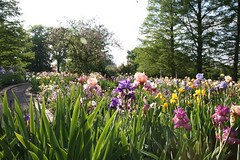 Goodman Iris Garden
Goodman Iris Garden
Hundreds of cultivars of bearded iris are in peak bloom around Mother's Day, representing nearly every color of the rainbow. Tall, intermediate, border and dwarf bearded irises, as well as Japanese, Spuria, Louisiana, Siberian and many rare species comprise this nationally-recognized collection. Many of the collection's bearded irises rebloom, repeating the flowering season from late August through late November.
Knolls
This picturesque landscape provides a scenic vista between the Milles Sculpture Garden and Henry Shaw's Mausoleum Garden. The Knolls feature slightly undulating topography and artfully-placed clumps of trees and shrubs. Since 1914, this has been a wonderful spot for visitors seeking a solitary, simple setting. Peak seasons of interest are spring, summer and autumn.
Milles Sculpture Garden
This sculpture garden consists of three large reflecting pools which span the Missouri Botanical Garden's central axis from the Spink Pavilion to the Climatron. The pools, built in 1913, have been fully renovated and display seven works by the late Swedish sculptor Carl Milles. Bald cypress trees frame the majestic vista, further accented by seasonal borders including pansies, tulips and summer annual displays. The tropical water lilies and giant Victoria water lilies peak in August and September, and have been a major Garden attraction since before the famed 1904 St. Louis World's Fair. From spring through fall, colorful glass Walla Wallas by artist Dale Chihuly bob in between the water lilies of the central pool.
Gladney Rose Garden
Shaped like a giant wheel, this garden displays hundreds of hybrid roses. Many climbing rose varieties are featured on the formal fence and arbors that enclose it. Peak display lasts from early summer through autumn.
Lehmann Rose Garden
This large rose garden contains historic cultivars, miniature roses, modern hybrid tea, floribunda and shrub roses, and test roses. A gazebo with a fountain and small pool can be found near the south end of the garden. Toward the center, the bubbling Kerchival Fountain entertains visitors. The dramatic Shapleigh Fountain at the north end of the garden is a favorite among children. Peak season of bloom is early summer and autumn.
Zimmerman Sensory Garden
Designed to delight the senses, this beautiful garden offers an engaging sensory experience for both the young and young-at-heart. Smell the heavenly scented flowers and spicy herbs, hear the trickle of the Shell Fountain and the ring of the Solari Bell Tree and touch the texturally tantalizing annuals, perennials and herbs. Peak months are May through October.
Showcased primarily in raised beds and container plantings, the plants in this garden are used for educational and therapeutic programming under the Missouri Botanical Garden’s Therapeutic Horticulture Program. Individuals of all abilities can enjoy what this garden has to offer.